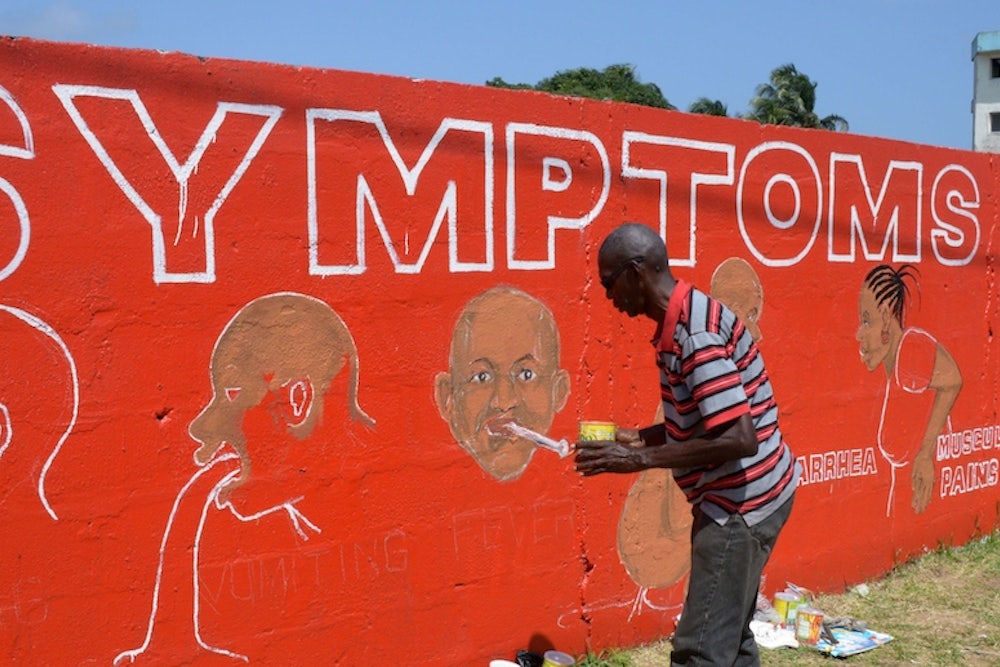Last week, as experts assembled at the World Health Organization headquarters in Geneva to discuss the Ebola outbreak in West Africa, there was a glaring absence in the public discourse: an accurate assessment of the U.S. government’s capacity to produce ZMapp, one of the experimental drugs under discussion for speeded approval. The drug, a cocktail of three monoclonal antibodies that has now been used in the treatment of at least seven Ebola patients, five of whom survived, has the potential to be an exceptional therapy against the virus. But the world’s supply is currently exhausted, and production of even several dozen additional doses of the drug remains months away.
But the U.S. government could in fact produce an extraordinary amount of the drug in a relatively short timeframe. A Defense Advanced Research Projects Agency (DARPA) program, launched in 2006 and led by Michael Callahan, an infectious disease doctor affiliated with Massachusetts General Hospital, wildly accelerated the rate at which vaccines and monoclonal antibodies like ZMapp can be produced. Callahan’s project was known as AMP, for Accelerated Manufacture of Pharmaceuticals, and, later, as Blue Angel. It pitted small biotech firms against one another, each competing to produce therapeutic agents in creative and relatively untested ways : DARPA’s original call for proposals suggested fungal fermentation, arthropod-transections, and aquatic or terrestrial plants as potential platforms. Tobacco plants eventually proved to be the most effective means of production.
In each round of the experiment, genetic code for a vaccine or drug was delivered to participants via email. Each phase, termed “Live Fire Tests,” demanded production of a logarithmically increasing amount of the assigned vaccine or antibody in an ever decreasing time frame. The final iteration of the challenge, which two firms successfully completed in 2012, demanded the production of 3 million doses of a vaccine in twelve weeks at the cost of no more than $1 per dose. That scale of production was unimaginable to those outside of DARPA before the experiment began.
Kentucky Biopharmaceuticals, the current manufacturer of ZMapp, was one the firms that participated in the later phases of the AMP/Blue Angel program. It was not rated as one of the highest-performing platforms, according to those close to the experiment. It did, though, benefit significantly from Pentagon funding, as did a number of other companies.
The president of one of the premier AMP/Blue Angel platforms, speaking on the condition of anonymity last week, told me that his firm could produce tens of thousands of doses of ZMapp within months and 3 million doses of the ZMapp within a year.
The drug, at this point, remains untested in humans. A study, published in Nature at the end of August, though, showed the ZMapp to be exceedingly effective in macaques, the animal model most closely matching human anatomy and physiology. And a CNN report on the treatment of Kent Brantly, a missionary doctor infected with Ebola while working in Liberia, suggests the therapy had a profound impact on his recovery. Brantly, after his condition severely worsened, was given a single dose of the drug, and, hours later, had improved remarkably, gaining strength to even shower himself the next day.
The next phase of traditional drug development would put ZMapp in healthy young men to screen for major side effects. Should that round succeed, a phase II trial involving those infected with the disease would begin, in order to determine effectiveness and optimal dosing. Because of the severity of the outbreak, some of those closest to the response argue the process should advance directly to phase II. Given the rapid progression of Ebola virus disease, such a trial could be conducted remarkably quickly.
If the political will existed, a hospital ship could arrive off the coast of West Africa within weeks, bringing with it the necessary equipment to carefully monitor patients’ responses to the drug. And, if additional AMP/Blue Angel platforms were put in motion, enough ZMapp to treat all of those likely to become infected might even be available before the year-end.
Yet, five months into the outbreak, the sort of political will required for such aggressive intervention still remains entirely absent in the leadership of the world’s most affluent states, not least of which, within the U.S. government.
The Obama administration has routinely frustrated those that have sought to define its foreign policy. The president has, though, in at least two instances, clearly demonstrated that he is a liberal interventionist. In 2011, as Mohammar Qaddafi’s forces neared the rebel-held city Benghazi, and again in August as ISIL forces attacked the Yazidis in Northern Iraq, the president mobilized the U.S. military to stop advancing militants and the certain suffering and slaughter of civilians. What, we should ask, makes this situation so different? As the outbreak expands now at an exponential rate, and as health systems in each of the affected nations continue to collapse, tens of thousands of lives quite clearly hang in the balance once more. The president, speaking on “Meet The Press” this weekend, said that containment of the outbreak must be a national security priority. He noted that, if the disease continues to spread unabated and the virus mutates to a more transmissible form, it could easily pose a danger to the United States. Why will we shirk at putting the strength of our defense establishment to work for this intervention, then?
If ZMapp proves an effective therapy in the coming months, as it likely will, the current contract for its production will guarantee that a wide deployment of the drug will still remain several additional months away. If the White House were to fund additional AMP/Blue Angel platforms to scale up the production of ZMapp, it would cost a fraction of the billions that have already gone into the program, and, in the worst case scenario, mean having to destroy doses if the drug proves ineffective or harmful.
On the balance, that is a disarmingly small price to pay.
